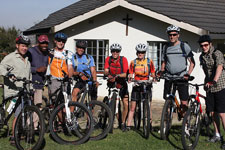
Donors are different these days. I’m talking about the individual donor, not foundations. And I’m particularly talking about the donors you hit up for more than $10 per month. How do you inspire donations in the $10,000 range?
While much attention is given to the nature of Millennials and their propensity to be more socially conscious, nonprofits need to take a second look at the older generations, the Baby Boomers and GenXers.
They’ve changed.
They’ve got disposable income and they are not like their parents were in retirement. They want adventure, involvement in something larger than themselves, and are willing to put sweat and money into causes.
Take those who signed up for a grueling 4-day mountain bike ride across the mountains in Swaziland. They each raised about $10,000 for Young Heroes, an organization that supports families caring for AIDS orphans. And these donors paid the cost of their airfare to Swaziland as well.
Those not up for the bike ride raised sizable donations as well and built playgrounds, digging holes in hard soil and mountainous terrain. Now why would anyone pay that much for such a torturous adventure?
Jeff Yoder, 56, summed it up best. He was looking for more significance in his life, something beyond making money. The trip was a life-changing experience:
I used to think “I want someday to be a philanthropist.” Now I say, “I can be a junior philanthropist now.” I’m 56. If I am going to do things in life, the time is now. Do I wait until I’m 75 to do good things? … I want to live now, make a contribution now .. The reason I am working is because I want to be able to be adventurous and generous. I can’t do that if I don’t have resources. I am working to generate resources.
He’ll be on the ride next year, he said. In the meantime, he has become an avid mountain biker and an engaged donor to other causes that provide help to Africa. His son Jacob, 17, made the trek and raised money as well. “He got to be in the company of other adults who are up to something, doing interesting things, who are interesting people,” Yoder said of his son. “It sparked something in him.”
How do you reach the Jeff Yoders of the world? How do you inspire a significant donation and a commitment to philanthropy, however “junior,” from entrepreneurs and leaders of mid-sized businesses? Those I spoke to about the Swazi Challenge cited a number of reasons for participating. They:
- were looking for an outlet for do-gooder instincts
- wanted adventure
- wanted to combine community service with vacation time
- cared about the cause
- knew someone who was passionate about the cause
- wanted their money to go directly to program services, not operating costs (This we’ll have to talk about.)
So what should a nonprofit do? Well, I’d quote Jeff Yoder for starters; that’s a powerful statement. Beyond that, here’s some tips learned from the Young Heroes donors:
- Be passionate: Participants are attracted to big events by the passion of the person recruiting them. First, it was the passion of Young Heroes staff in reaching out to riders and playground builders, who then passed that passion on to the people they asked to sponsor them. “I felt strongly about it,” said Dave Vesty who, with his wife, built playgrounds. “It’s got to be worth it [to others] if you feel strongly.”
- Connections, connections, connections: Vestry found out about the ride from a college friend he’d been out of touch with for years. That friend introduced him to Steve Kallaugher, passionate board member of Young Heroes. Riders tapped their connections, from college to colleagues, from corporate matching funds to family and friends. This is a perfect time to use “advanced search” on LinkedIn.
- It’s the Information Age: Before he signed on, Vesty did his own research about the organization. When he did sign on, he had information ready to give those he was “hitting up.” Charity Navigator’s new rating system may be a blessing. A lot of information will be available at a third-party site. If your organization is too small to merit CN’s attention, you can provide the info on your site. Just make sure the information is easily available somewhere, both online and in printed form so people can hand it out.
- Stories and faces matter: Facts appeals to people’s heads. Stories tug their heartstrings and keep them coming back. Yoders was impressed — and will remain a supporter — because he spoke with a grandmother who was caring for eight or 10 children left behind by parents who died of AIDS. “Don’t stop helping,” she told Yoder. “I’m going to die and they will be all alone.” Yoder realized that the problem is not going away. He can’t walk away from it now. Make sure donors can’t walk away from your nonprofit’s mission.
- Get the “operating expense are important” message out there: As one donor noted, he was impressed that 100% of the money raised by the Swazi Challenge goes directly to the children, not to operating expenses. But the children don’t get the services if no one is there to oversee delivery of the services and keep the books. Operating expenses allow programs to be delivered. Yes, excessive overhead can indicate a problem. That’s what accountability and transparency are about. Be accountable. Be transparent. Open your books so all can see how much staff you have and how much they are paid. And include a “day in the life” of the staff member or a job description so each one’s contribution to the program is clear.
How do you inspire major donors? What tips can you add to this list?
Photo: 2011 Swazi Challenge Cyclists / Jeff Yoder and his son Jacob are far right.
